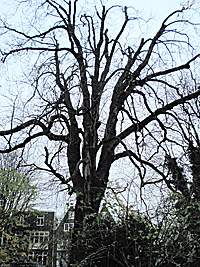By Joel Magalnick, Editor, JTNews
Even trees have life spans. But one tree, a horse chestnut known to generations of teenagers the world over as the only connection to the outside world for a young woman in hiding during the Holocaust, is getting a new life. Eleven new lives, actually.
“There was some talk of cutting it down about a year or two years ago, and there was a big uproar and protest,” said Ilana Kennedy, director of education at the Washington State Holocaust Education Resource Center.
When she began to read reports that authorities in Amsterdam would take cuttings from this storied tree and grow saplings so it could live on, Kennedy tried figure out a way to get one of those saplings to Seattle.
“I couldn’t quite connect the dots on what we could do with a tree,” Kennedy said. “What was I going to do, plant it and water it or something?”
But then Kennedy, who said she has “a very black thumb,” got a call from the Seattle Dept. of Parks and Recreation. It turned out that the parks superintendent had been paying attention to the plight of the Anne Frank tree and was hoping to bring one of the saplings to Seattle as well. So one of the foresters called Kennedy and made the connection.
“He was going to take care of it, they were going to plant it, find the place,” Kennedy said. “We just had to come up with the educational plan, which is what they were looking for, which is what we’re about anyway.”
So Kennedy drew up the proposal to the New York-based Anne Frank Center, which had to show how the tree might be used to teach tolerance and commemorate some event in that community that had displayed a type of intolerance.
“The timing on this is actually quite interesting,” Kennedy said, “because what I proposed was I wanted the tree to symbolize not just tolerance, and to be a reminder in Seattle of this, but to also commemorate the [Jewish Federation] shooting that happened here in 2006.”
Kennedy had testified in the Federation gunman’s retrial the day she spoke with JTNews.
But more than memorialize the shooting at the Jewish Federation of Greater Seattle itself, she wanted to show how different groups within Seattle’s community responded after that tragedy.
“I thought, that’s what we want to remember: What happens when we all come together over something,” she said. “So we put that in the proposal, along with our educational plan on teaching about the Holocaust and about teaching tolerance.”
Kennedy contacted several organizations both in and out of the Jewish community to sign on as supporters of the application, and built a list that includes the Washington State Jewish Historical Society, the Jewish Federation, the Northwest African American Museum, the Pride Foundation and others.
The Holocaust Center learned on Oct. 16 that they would be one of 11 sites in the U.S. to receive saplings from the tree. Other locations include the White House, the Boston Common, Idaho’s Anne Frank Human Rights Memorial, and the National September 11 Memorial & Museum in New York.
According to Yvonne Simons, executive director of the Anne Frank Center USA, which decided upon the recipients of the saplings, the Holocaust Center’s application was chosen both because of the proposed site and “your excellent online resources to involve the community and the fact you have a Holocaust speakers bureau,” Simons said in a statement. “Your message of tolerance was well received and compelling.”
Simons also cited the Federation shooting as a consideration.
Mark Mead, an urban forester who works in the parks department, said they decided upon Volunteer Park in Seattle’s Capitol Hill neighborhood partly because of its central location, but also because of its historical status as a John Olmsted-designed park and the draw for the Asian Art Museum and the conservatory. The tree will likely not need to acclimate to Seattle weather.
“The species is very adapted to this area, and there’s no real consideration in regard to [that] other than standard preparation,” Mead said.
Reports had stated that the saplings at the 11 locations would be held under a two-year quarantine before being allowed to take root, but in Seattle’s case at least, the parks department has a workaround.
Because there is already a stand of horse chestnuts in Volunteer Park, and the conservatory imports plants, the location passed muster. The sapling will be kept in the conservatory, though accessible to the public, for two years until it’s ready to be planted.
Mead said his department was excited about the prospect of working with the Holocaust Center in building a new home for this descendant of the Anne Frank tree.
“We feel it’s going to be a real focal point and we’re looking for a lot of buy-in from the community,” he said.
Kennedy agreed.
“I think Anne Frank is kind of a common denominator when you talk about the Holocaust and intolerance and you’re looking at youth who are being persecuted,” she said.
